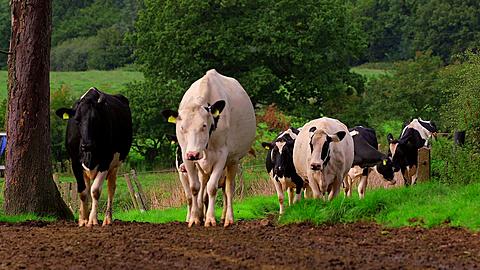
The price of food is inelastic. This means that if the output of food increases, you won’t eat more. Even if the price drops you’re not going to eat an extra meal a day.
If the output falls, then you’re not going to say, ‘fair enough, food’s too dear, I’ll only eat every other day, not a problem.
In times for famine people sell their children.
The problem is that over long experience (about four thousand years) it’s been discovered that round about a 5% shortfall in production produces major food price rises as people scrabble to buy it and a 5% over production produces major food price crashes.
It’s always been true, (get hold of the book ‘The Grain Market in the Roman Empire’ for example)
Because of this, the basic rule in agriculture has been that farmers go bust in years of plenty and make money in famines.
The problem is that if you plant the same crop in the same field with the same fertiliser in two consecutive years, then the yield can differ by 10% just due to ordinary weather conditions. That’s without extremes
So the EU set up the CAP. The idea was that they’d aim to produce a built-in surplus. Only a couple of percent and in good years they’ll stockpile a bit and in the bad years they’ll draw from out of the stockpiles (hardly rocket science, see Genesis 41)
The problem is that because this always ensures a surplus, then the prices will stay low and agriculture will collapse after a few years of it.
So to guarantee production AND keep prices at a sensible average, they paid farmers to survive.
There is a second reason for this as well. When the EU was formed, there was a fear that the post war rural population in France and Italy were largely Communist, because the Communists had been the pillars of the resistance and almost by definition their strongholds were in rural areas. Their grip on the rural population was strengthened by the fact that agriculture was in total collapse due to the war and the peasantry had nothing to lose by supporting the Communists. The CAP was thus supposed to guarantee the rural population had a decent level of income and encourage them to ‘buy into’ the new post-war liberal consensus.
Article 39b of the treaty of Rome specifically states “thus to ensure a fair standard of living for the agricultural community, in particular by increasing the individual earnings of persons engaged in agriculture”
At the moment we’re at a tricky stage in the evolution of agricultural policy. If you go to https://fullfact.org/economy/farming-subsidies-uk/ you’ll see the following statement;-
“The average farmer made £28,300 in subsidies last year and £2,100 from agriculture. The average cereal farmer lost £9,500 on agriculture.”
Because governments have been so keen to keep food prices and inflation as low as possible, (in general but especially since 2008 and the financial crisis followed by very slow wage rises) they’ve encouraged the sale of food at below the cost of production. Now we could reduce the cost of production, but here we have another problem, virtually all agriculture in Europe, done to EU standards of animal health and welfare, is economically nonviable without support.
The two largest unsupported sectors are pigs and poultry, and they survive by working on an industrial scale and using practices that consumers largely dislike. But this dislike translates into perhaps 10% of the population doing something about it as in spending more money. (Occasionally it hits 15% in prosperous times, perhaps even 20% briefly, but it always falls back.)
So the EU (and UK) have a choice. They either provide support to the industry, (but they cannot do it through price support because that’s banned under WTO and so support is paid for environmental and animal health and welfare reasons) and keep the sort of agriculture they’re happy with.
Or they cut support and have economic agriculture. This will either mean, for example, 5,000 cow dairy herds, housed indoors all year round, and with matching beef finishing units, because that’s the scale needed, or it will mean not actually producing food at all. (The biggest US unit is apparently 30,000 cows; the Chinese are building one for 40,000)
The irony of it is that, as the horsemeat fiasco showed, the UK population hedges its own agricultural industry around with expensive regulation and then imports any cheap crap it can find ‘because food’s too dear.’
Another route we could go down is cheap labour. Actually it is the other route we go down. Some of it is migrant labour.
The number of people working on United Kingdom farms is about 481,000
Apparently the number of non-UK born workers employed on UK farms is 34,513.
So the number of migrant workers in the industry is about 7%, but the vast majority of those working in the industry are self–employed and for many of them, even with subsidy, they’re earning less than the minimum wage for the hours they work. Remember as a dairy farmer I was habitually working a twelve hour day, milking at 6am in the morning and finishing milking at 6pm in the evening, and Sunday was my day off, but obviously I still have to milk twice a day and feed everybody as well. These hours are not uncommon, month in and month out. But there again I suspect they’re the sort of hours many small shopkeepers will recognise, and I admit their row is harder to hoe than mine was. I didn’t have to be polite to people all day.
Tagged: CAP, migrant workers, selling children because of famine


Between the devil and the deep blue sea.
If you were in charge, what would you do? Now that Brexit has been voted for, what would you do – if they listened to you.
Brexit doesn’t need to make any difference. We had a support system based on deficiency payments (a variable payment which made up the difference between price and cost of production) which worked very well and was considerably simpler and far easier to implement than the grossly over-bureaucratic system they have now. It could well be possible to introduce something similar but would have to fit in with WTO rules
IT seems to me that we have to accept that eating meat costs money, and really it’s a luxury, so we need to reeducate the populous that they can’t afford to eat meat every meal. At some point, when the distribution of wealth has equalised a lot more luxury items like cocoa and beef will, once again, be luxury items priced at the cost of production. I remember seeing a film about wonky veg – cauliflowers – and saying it was a pity that they couldn’t give the ones which were still too wonky to the food bank. She replied that the kinds of folk who used food banks were not going to eat cauliflower and many wouldn’t know how to cook it.
We do have a real ignorance in this country of where food comes from, how to eat well and cheaper: markets, fresh stuff, seasonal, local stuff, pulses and beans some meals instead of meat, shellfish instead of pre packed crumbed cod. I’m not sure how we can address it other than teaching gardening in schools and changing people’s outlook so cookery, as opposed to opening packets and heating the contents, is seen as a life skill.
Really interesting reading.
Cheers
MTM
we’re probably going to have to look seriously at education. It’s time that we looked at teaching people useful stuff that they’ll actually need.
A previous generation learned from their parents, but now in many cases the parents often haven’t a clue either
Yeh, tell me about it. 🙂
Reblogged this on Kate McClelland.
glad you liked it Kate 🙂